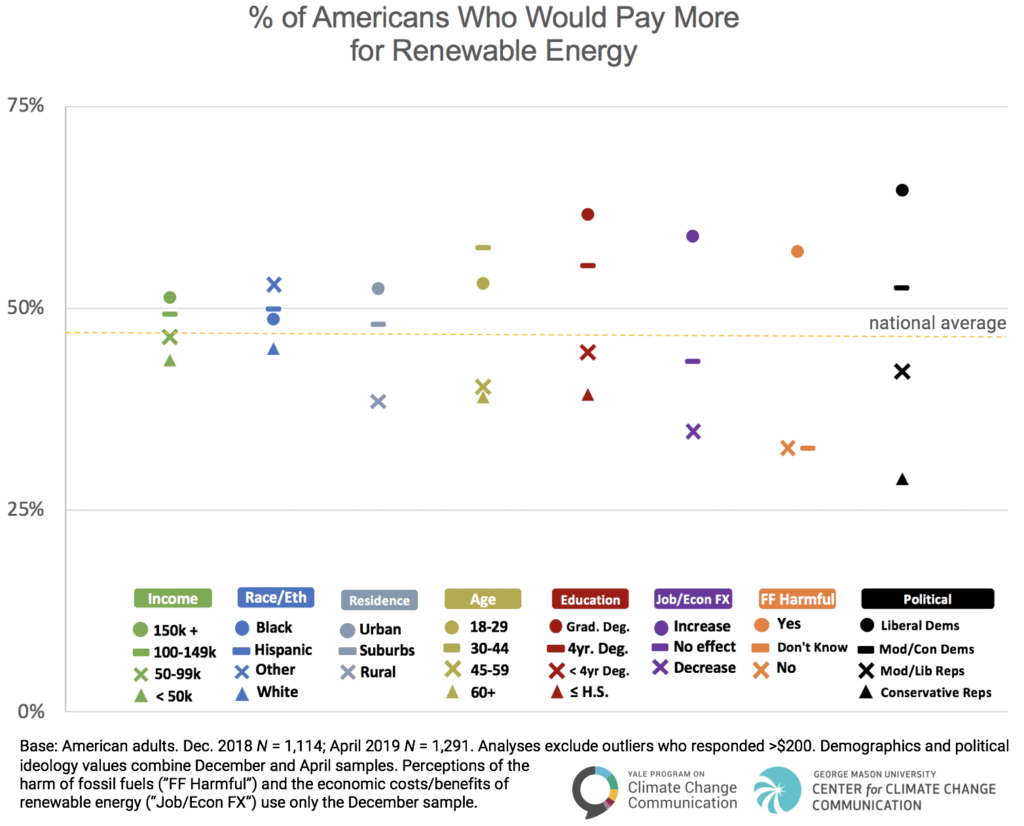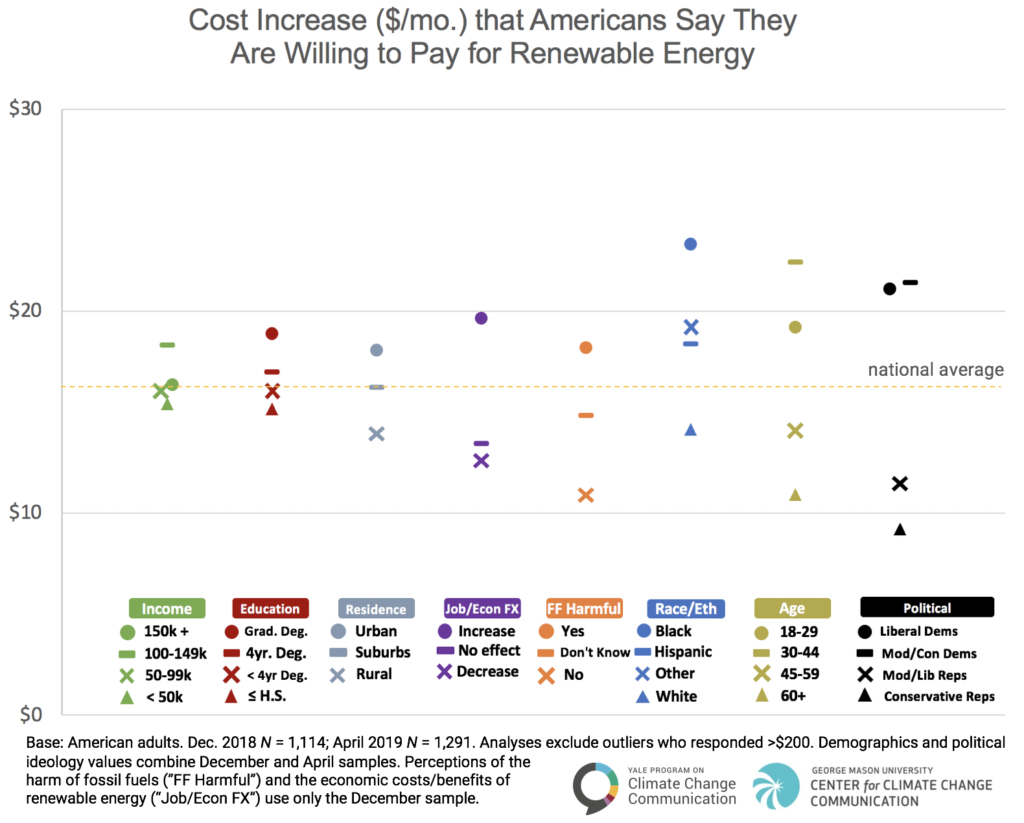Climate Note · Jul 16, 2019
Who is willing to pay more for renewable energy?
By Abel Gustafson, Matthew Goldberg, Seth Rosenthal, John Kotcher, Edward Maibach and Anthony Leiserowitz
Filed under: Behaviors & Actions

In our December 2018 Energy in the American Mind report, we found that a bipartisan majority (85%) of American registered voters support requiring electric utilities to transition to renewable energy, even though only 38% think that wind and solar cost less than electricity from coal. This suggests that many Americans may be willing to pay more to get their electricity from renewable sources. Here, we report findings about who is willing to pay more for renewable energy, and how much more they are willing to pay.
In two recent national surveys of American adults, we asked how much more per month, if anything, people would be willing to pay to get their electricity from 100% renewable sources. Nearly half of Americans (47%) reported that they were willing to pay more, while 50% said $0.
The Americans most willing to pay more for renewable energy are those who think that air pollution from fossil fuels is harmful to human health, those who think that renewable energy increases jobs and strengthens the economy, those with a graduate degree, and liberal Democrats. These findings corroborate prior research which found that most Americans support renewable energy because they see it as more affordable (cheap) or less harmful (clean). People who earn more money are not more likely to be willing to pay more for renewable energy, indicating that willingness to pay more is not primarily a question of the ability to afford it.
Overall and on average, Americans are willing to pay an additional $16.25 per month for renewable energy. About one in six (17%) say they would pay between $1 and $10 more, while 15% are willing to pay between $11 and $30, and 14% are willing to pay between $31 and $200 more. Among those who are willing to pay at least some amount more per month, the average is $33.72 per month.
The amount that Americans say they are willing to pay for renewable energy also varies significantly by political ideology, with Democrats, younger adults, and racial/ethnic minorities all willing to pay more. The averages below are calculated including the respondents who said “$0.”
It is important to note that public willingness to pay more for renewable energy is likely to become less relevant in coming years, because the costs of generating electricity from renewable energy sources have been rapidly declining . Increasingly, Americans will not have to decide if they are willing to pay more for renewable energy. Rather, they will likely be able to pay less for renewable energy. Because nearly half of Americans are already willing to pay more for renewable energy, we expect that consumer demand and positive sentiments will increase as renewable energy prices fall.
Methods
These data were produced by the bi-annual Climate Change in the American Mind survey conducted by the Yale Program on Climate Change Communication and the George Mason University Center for Climate Change Communication. Surveys were conducted using the Ipsos KnowledgePanel®, a representative online panel of U.S. adults (18+), from November 28 to December 11, 2018 and from March 29 to April 9, 2019. All questionnaires were self-administered by respondents in a web-based environment. This report includes the registered voters (2018 N = 966; 2019 N = 1,097) from the full samples (2018 N = 1,114; 2019 N = 1,291). Unweighted base sizes for the political subgroups by year are as follows: 2018 Democrats (liberal Democrats n = 295, moderate/conservative Democrats n = 168), 2018 Republicans (conservative Republicans n = 238, moderate/liberal Republicans n = 116). 2019 Democrats (liberal Democrats n = 264, moderate/conservative Democrats n = 209), 2019 Republicans (conservative Republicans n = 320, moderate/liberal Republicans n = 165). Bases specified are unweighted, but percentages and means are weighted to align with U.S. Census parameters.
Willingness to pay more for renewable energy was assessed with a question asking “How much more, if any amount, would you be willing to pay each month on your electricity bill to purchase 100% of your electricity from clean, renewable sources (such as wind and solar)?” Responses were provided in a free- response text box. Outliers who responded with an amount greater than $200 per month were excluded from the calculations of means.
Perceptions of whether fossil fuels harm human health were assessed only in the December 2018 survey. This was done using a question asking “In your view, does air pollution from the use of fossil fuels harm the health of Americans?” with response options of “Yes,” “No,” and “Don’t know.” Similarly, perceptions of the economic effects of transitioning to renewable energy were assessed only in the December 2018 survey, using a question asking “Overall, government policies intended to transition away from fossil fuels (coal, oil, natural gas) and toward clean energy (solar, wind) will…” with responses given on a three-point scale of “Reduce economic growth and cost jobs,” “Have no impact on economic growth or jobs,” and “Improve economic growth and provide new jobs.”

